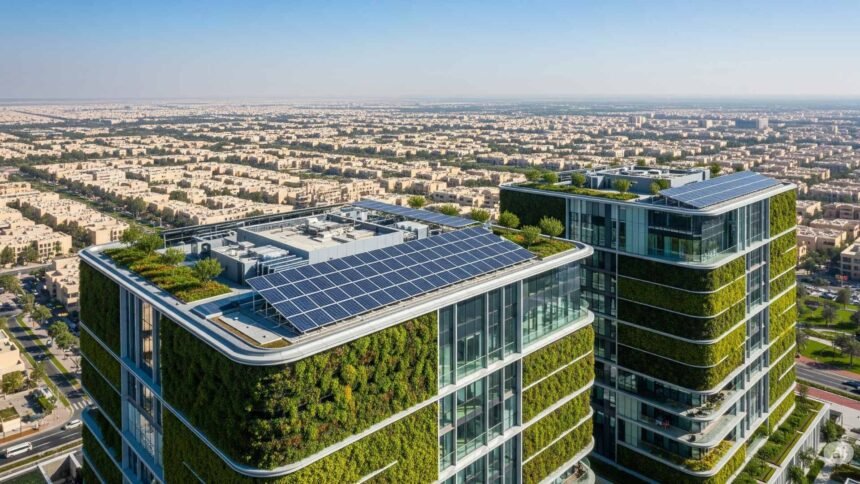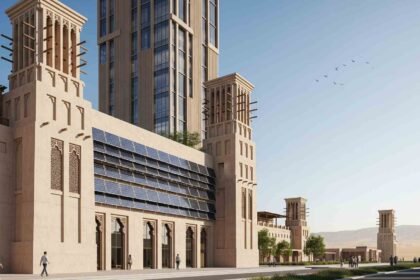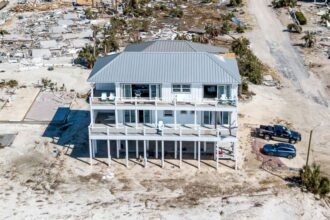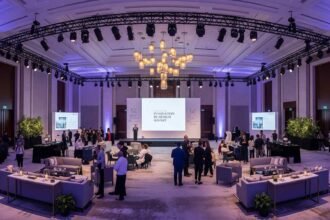In recent years, the Gulf region has undergone a remarkable transformation in its approach to construction and urban development. What was once viewed as a luxury—green building practices—has now become an absolute necessity. Driven by environmental concerns, economic diversification, and technological advancements, the Gulf Cooperation Council (GCC) countries, including the United Arab Emirates (UAE), Saudi Arabia, Qatar, Bahrain, Kuwait, and Oman, are leading the charge in sustainable construction. As we approach 2025, the region is setting new benchmarks for eco-friendly materials, energy-efficient designs, and carbon-neutral initiatives, positioning itself as a global leader in green building.
The Rise of Green Building in the Gulf
The GCC region is rapidly embracing sustainable construction practices, recognizing that green building is no longer just an option but a critical component of economic and environmental resilience. According to a report by Matsh, the GCC is pioneering green design trends, with a focus on transforming how cities are built in the Middle East. The UAE, in particular, is at the forefront, with its Dubai 2040 Urban Master Plan emphasizing green infrastructure and mandating green building standards for all new constructions by 2025. The country has also invested $19 billion in sustainable urban projects, such as Masdar City, which aims to be a zero-carbon, zero-waste city.
Saudi Arabia is equally committed, with its Vision 2030 driving the adoption of green building materials and the launch of the NEOM project—a $500 billion futuristic city powered entirely by clean energy and advanced green technologies. These initiatives reflect a broader regional shift toward sustainability as a core value for environmental reasons and to diversify economies traditionally reliant on oil and gas.
Key Trends Shaping Green Building in 2025
As we look toward 2025, several key trends are reshaping the green building landscape in the Gulf:
- Innovative Materials and Technologies
- Recycled and Eco-friendly Materials: The use of recycled aggregates, eco-friendly insulation, and low-emission glass is becoming standard. These materials reduce carbon footprints while enhancing building durability and efficiency.
- Building Information Modeling (BIM): BIM is widely adopted to optimize construction processes, reducing material waste by up to 30% and improving project efficiency.
- AI and Digital Twins: Artificial Intelligence (AI) is transforming construction workflows and decision-making. Digital twins, which simulate building performance, are boosting productivity by 25-40%.
- Drone Surveying and Robotic Automation: Drones are used for faster and more accurate site surveys, while robotic automation is improving labor efficiency by 35%.
- Sustainability as a Core Value
- A survey by Versatile International with Ipsos found that 55% of industry professionals view sustainability as a key driver of innovation in 2025. This includes integrating renewable energy sources and obtaining green building certifications like LEED.
- The green building market in the GCC is projected to reach USD 39.72 billion by 2025, with a compound annual growth rate (CAGR) of 10.96% leading up to 2030.
- Government Policies and Initiatives
- The UAE has mandated green building standards for all new constructions by 2025 and is investing heavily in sustainable urban projects.
- Saudi Arabia’s Vision 2030 and the NEOM project are setting new benchmarks for sustainable development.
- Dubai has implemented the Al Sa’fat green building rating system, which has already reduced CO₂ emissions by 2.28 million metric tonnes.
The Importance of Green Building Certifications
Green building certifications are playing a pivotal role in the Gulf’s sustainable construction landscape. Certifications like LEED (Leadership in Energy and Environmental Design) provide a framework for buildings to meet high environmental standards, ensuring they are designed and operated with minimal environmental impact. In Dubai alone, there are 348 LEED-certified buildings, showcasing the city’s commitment to sustainability. Additionally, certifications like Al Sa’fat incentivize developers to adopt green practices, contributing to significant reductions in carbon emissions.
Landmark Projects Leading the Way
The Gulf region is home to several groundbreaking green building projects that exemplify its commitment to sustainability:
| Project | Location | Key Features | Investment/Impact |
| Masdar City | UAE | Zero-carbon, zero-waste city with advanced solar technology and smart waste management | $19 billion investment |
| NEOM | Saudi Arabia | Futuristic city with 100% clean energy and comprehensive recycling systems | $500 billion investment |
| Dubai Sustainable City | UAE | Net Zero Energy community with solar panels, water management, and green spaces | 46,000 sqm, 3,000 residents since 2015 |
- Masdar City (UAE): A zero-carbon, zero-waste city powered by advanced solar technology and smart waste management systems.
- NEOM (Saudi Arabia): A $500 billion project aimed at creating a futuristic city with 100% clean energy and comprehensive recycling systems.
- Dubai Sustainable City: A Net Zero Energy community spanning 46,000 sqm, home to nearly 3,000 residents since 2015, featuring solar panels, water management systems, and extensive green spaces.
Challenges and Opportunities
Despite its progress, the Gulf region faces challenges in its green building journey. A survey highlighted labor shortages as a significant concern, with 56% of respondents citing it as an issue over the next five to ten years. Additionally, 46% identified the need for more specialized skilled employees, while 51% pointed to rising costs and project complexity as current obstacles. However, these challenges also present opportunities. The focus on sustainability and AI is creating new jobs and fostering innovation. Moreover, 53% of professionals see regional market expansion as a primary growth area, emphasizing the potential for collaboration and workforce development.
The Future Outlook
Looking ahead, the Gulf region is poised to continue its leadership in green building trends. With a focus on green technologies like hydrogen and a commitment to carbon neutrality, the region is setting a global standard for sustainable construction. The integration of AI, BIM, and other digital tools will further enhance the efficiency and sustainability of building practices. As the world grapples with climate change and resource scarcity, the Gulf’s approach to green building—from luxury to necessity—serves as a model for other regions to follow. By 2025, sustainable cities and buildings will no longer be exceptions but the norm.







